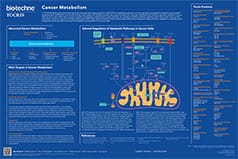SREBP
SREBPs (sterol regulatory element-binding proteins) are membrane bound transcription factors that are essential in the regulation of cholesterol, fatty acid and triglyceride biosynthesis. There are two SREBP genes in mammals, SREBP-1 and SREBP-2.
SREBP Inhibitors |
|
|---|---|
| Cat. No. | 产品名称/活性 |
| 4444 | Fatostatin A |
| Cell permeable inhibitor of SREBP activation | |
| 3354 | PF 429242 dihydrochloride |
| Competitive inhibitor of SREBP site 1 protease | |
SREBPs (sterol regulatory element-binding proteins) are membrane bound transcription factors that are essential in the regulation of cholesterol, fatty acid and triglyceride biosynthesis. There are two SREBP genes in mammals, SREBP-1, which is most abundant in the liver and adrenal glands, and SREBP-2, which is ubiquitously expressed. In addition, SREBP-1 encodes two different isoforms of the protein, SREBP-1a and SREBP-1c, expression of which is dependent on the promoter. The proteins form a subgroup of the larger class of bHLHZ (basic-helix loop-helix leucine zipper domain) transcription factors. SREBP-1c primarily regulates fatty acid metabolism, including the fatty acid synthase (FASN) gene, SREBP-2 is primarily responsible for cholesterol metabolism-related genes, including HMG-CoA reductase, while SREBP-1a targets both.
SREBPs are synthesized as inactive precursors bound to the endoplasmic reticulum (ER). When intracellular cholesterol levels are low, SREBP cleavage activating protein (SCAP), which acts as a cholesterol sensor, transports SREBP from the ER to the Golgi apparatus, where it is cleaved by site-1 protease (S1P). The amino-terminal bHLHZ domain is then further cleaved by site-2 protease (S2P) giving rise to nSREBP (or nuclear SREBP), which translocates to the nucleus where it activates transcription. SREBP-1a appears to be constitutively expressed at low levels, whereas expression of SREBP-1c and SREBP-2 is regulated by a feed-forward loop whereby nSREBPs activate transcription of their own genes. SREBP-1c is also regulated by liver X receptors, insulin and glucagon.
Insulin stimulates the production of fatty acids in the liver at times of carbohydrate excess. Evidence suggests that this effect of insulin is mediated by SREBP-1c via the PI 3-kinase/Akt signaling pathway, and that the fatty liver associated with insulin resistance is due to elevated SREBP-1c levels. Drugs targeting SREBP may therefore have potential to treat metabolic disorders, such as type II diabetes and insulin resistance, as well as atherosclerosis. SREBP could also be a potential target in cancer therapy, since cancer cells require increased lipogenesis for growth and proliferation.
Literature for SREBP
Tocris offers the following scientific literature for SREBP to showcase our products. We invite you to request* your copy today!
*Please note that Tocris will only send literature to established scientific business / institute addresses.
Cancer Metabolism Poster
This poster summarizes the main metabolic pathways in cancer cells and highlights potential targets for cancer therapeutics. Genetic changes and epigenetic modifications in cancer cells alter the regulation of cellular metabolic pathways providing potential cancer therapeutic targets.

